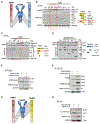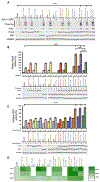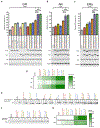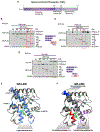A specialized Hsp90 co-chaperone network regulates steroid hormone receptor response to ligand
- PMID: 35830801
- PMCID: PMC9306012
- DOI: 10.1016/j.celrep.2022.111039
A specialized Hsp90 co-chaperone network regulates steroid hormone receptor response to ligand
Abstract
Heat shock protein-90 (Hsp90) chaperone machinery is involved in the stability and activity of its client proteins. The chaperone function of Hsp90 is regulated by co-chaperones and post-translational modifications. Although structural evidence exists for Hsp90 interaction with clients, our understanding of the impact of Hsp90 chaperone function toward client activity in cells remains elusive. Here, we dissect the impact of recently identified higher eukaryotic co-chaperones, FNIP1/2 (FNIPs) and Tsc1, toward Hsp90 client activity. Our data show that Tsc1 and FNIP2 form mutually exclusive complexes with FNIP1, and that unlike Tsc1, FNIP1/2 interact with the catalytic residue of Hsp90. Functionally, these co-chaperone complexes increase the affinity of the steroid hormone receptors glucocorticoid receptor and estrogen receptor to their ligands in vivo. We provide a model for the responsiveness of the steroid hormone receptor activation upon ligand binding as a consequence of their association with specific Hsp90:co-chaperone subpopulations.
Keywords: CP: Molecular biology; FNIP1; FNIP2; Hsp90; Tsc1; androgen receptor; chaperone; chaperone code; co-chaperone; glucocorticoid receptor; steroid hormone receptors.
Copyright © 2022 The Author(s). Published by Elsevier Inc. All rights reserved.
Conflict of interest statement
Declaration of interests The authors declare no competing interests.
Figures






Similar articles
-
Emerging Link between Tsc1 and FNIP Co-Chaperones of Hsp90 and Cancer.Biomolecules. 2022 Jul 1;12(7):928. doi: 10.3390/biom12070928. Biomolecules. 2022. PMID: 35883484 Free PMC article. Review.
-
The FNIP co-chaperones decelerate the Hsp90 chaperone cycle and enhance drug binding.Nat Commun. 2016 Jun 29;7:12037. doi: 10.1038/ncomms12037. Nat Commun. 2016. PMID: 27353360 Free PMC article.
-
Post-translational Regulation of FNIP1 Creates a Rheostat for the Molecular Chaperone Hsp90.Cell Rep. 2019 Jan 29;26(5):1344-1356.e5. doi: 10.1016/j.celrep.2019.01.018. Cell Rep. 2019. PMID: 30699359 Free PMC article.
-
The switch from client holding to folding in the Hsp70/Hsp90 chaperone machineries is regulated by a direct interplay between co-chaperones.Mol Cell. 2022 Apr 21;82(8):1543-1556.e6. doi: 10.1016/j.molcel.2022.01.016. Epub 2022 Feb 16. Mol Cell. 2022. PMID: 35176233
-
Functional specificity of co-chaperone interactions with Hsp90 client proteins.Crit Rev Biochem Mol Biol. 2004 Sep-Dec;39(5-6):279-95. doi: 10.1080/10409230490892513. Crit Rev Biochem Mol Biol. 2004. PMID: 15763706 Review.
Cited by
-
Cryo-EM reveals how Hsp90 and FKBP immunophilins co-regulate the glucocorticoid receptor.Nat Struct Mol Biol. 2023 Dec;30(12):1867-1877. doi: 10.1038/s41594-023-01128-y. Epub 2023 Nov 9. Nat Struct Mol Biol. 2023. PMID: 37945740 Free PMC article.
-
Tenth International Symposium on the Hsp90 chaperone machine : Switzerland, October 19-23, 2022.Cell Stress Chaperones. 2023 May;28(3):231-237. doi: 10.1007/s12192-023-01342-z. Epub 2023 Apr 18. Cell Stress Chaperones. 2023. PMID: 37071341 Free PMC article. Review.
-
Activation of autophagy depends on Atg1/Ulk1-mediated phosphorylation and inhibition of the Hsp90 chaperone machinery.Cell Rep. 2023 Jul 25;42(7):112807. doi: 10.1016/j.celrep.2023.112807. Epub 2023 Jul 14. Cell Rep. 2023. PMID: 37453059 Free PMC article.
-
PhosY-secretome profiling combined with kinase-substrate interaction screening defines active c-Src-driven extracellular signaling.Cell Rep. 2023 Jun 27;42(6):112539. doi: 10.1016/j.celrep.2023.112539. Epub 2023 May 25. Cell Rep. 2023. PMID: 37243593 Free PMC article.
-
Saccharomyces cerevisiae as a tool for deciphering Hsp90 molecular chaperone function.Essays Biochem. 2023 Sep 13;67(5):781-795. doi: 10.1042/EBC20220224. Essays Biochem. 2023. PMID: 36912239 Free PMC article.
References
-
- Abdou NI, Rider V, Greenwell C, Li X, and Kimler BF (2008). Fulvestrant (Faslodex), an estrogen selective receptor downregulator, in therapy of women with systemic lupus erythematosus. clinical, serologic, bone density, and T cell activation marker studies: a double-blind placebo-controlled trial. J. Rheumatol 35, 797. - PubMed
-
- Adams A, Gottschling DE, Kaiser CA, and Stearns T. (1997). Methods in Yeast Genetics (Cold Spring Harbor Laboratory Press; ).
-
- Baba M, Hong SB, Sharma N, Warren MB, Nickerson ML, Iwamatsu A, Esposito D, Gillette WK, Hopkins RF 3rd, Hartley JL, et al. (2006). Folliculin encoded by the BHD gene interacts with a binding protein, FNIP1, and AMPK, and is involved in AMPK and mTOR signaling. Proc. Natl. Acad. Sci. USA 103, 15552–15557. 10.1073/pnas.0603781103. - DOI - PMC - PubMed
Publication types
MeSH terms
Substances
Grants and funding
LinkOut - more resources
Full Text Sources
Miscellaneous

